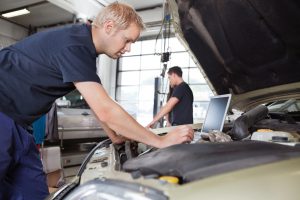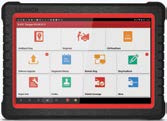Cars and Computer Diagnostics
Introduction
In the early 90’s, vehicles began the biggest change since Henry Ford rolled his first edition off the assembly line. Nowadays, computerization holds sway.
Vehicles have gradually gone from carbureted and naturally aspirated engines to computerized machines. Car repair is not what it used to be. Now, major operating systems are all monitored and controlled electronically.

The vehicle service and repair industry has gone from mechanics to repair technicians, from grease monkeys to a blend of old school mechanics and computer techs. These changes have dramatically altered vehicles and how drivers interact with them for the better. Car repair is all the much better off too.
Computerized technology has given us smoother running and faster cars. Auto parts that are stronger and lighter have played their role as well. In the old days, 300 horsepower was a speed king.
Now, 300 horsepower is middle-of-the-road fast while the big news is 400, 500, even 1,000 horsepower cars. Emerging and improved technology keeps the changes coming, and techs are constantly learning so they stay current with the newest advances.
Again, more durable auto parts made with more precise machining has greatly aided this progress.Car diagnostics has also kept pace to the point that many in earlier generations would not even recognize what is called car diagnostics today.
Driverless vehicles of all types including 18-wheelers are now all the talk. Of course, the technology behind them is now at the fore. Passengerless vehicles, anyone? Nah, what would be the point; except maybe a real life video game. Yeah, now that is the ticket!
What Computer Diagnostics Do
Car diagnostics is now called computer diagnostics. Are car diagnostics and computer diagnostics the same? Well, yes and no; computerized diagnostics goes a lot farther than the older car diagnostics. They give the technician a view of the car’s vital systems. These internal parts and their status are accessed with a diagnostic scan tool. Much like you scan your desk top or other computer when issues arise, this scanner is the vehicle equivalent.
This tool is a computer, and it has a multi-pin, rectangular computer port plug-in. It is plugged into the car’s computer port, located on the driver’s side at the bottom of the dash. The technician plugs in the diagnostic tool and follows the on-screen prompts to access the main engine control computer and scans it to locate and resolve the problem.
As the diagnosis progresses, the computer gives feedback analysis on the essential systems of the vehicle. It identifies the system that is issuing irregular or inconsistent activity. The process uses OBD I or OBD II applications. OBD stands for, you guessed it already, ‘On Board Diagnostics’. The I or II indicates different versions. Logical, since the computer reveals the status of all the ‘on board’ systems that of the vehicle.
Basically, as the diagnostic tool interfaces with the computer installed in the engine at the factory, it gives the tech an engine analysis. This diagnosis points the technician in the right direction for finding and repairing the dysfunctional part or system.
These tools are also used to re-program electronically controlled modules. These electronic components are assigned working limits or established parameters when they are installed. They are ‘watched’ or monitored by control modules.
When that control module senses a breach of those parameters, it signals the engine computer. The signal is called a DTC or Diagnostic Trouble Code. This signal or code then appears on the scanner’s screen in the form of a code for that system or part.
The technician then knows to check and test the part or check circuit wiring and electronics that monitor that particular system or part. Much of the old school car diagnostics was framed around guessing about the three essentials of the pre-computer engines, spark, air and fuel is eliminated. When you compare car diagnostics with computer diagnostics, you can see how advanced vehicles have come.
With the old car diagnostics, there was no electronic internal engine help. Now, the engine is, in essence, pointing to what component needs reprogramming or replacing. OBD has at least pinpointed the system issuing the code to the scan tool. However, the tech still must go through a process of evaluation based on what the OBD indicates.
The immense benefit is immediately obvious. The tool gives specific repair parameters, and this eliminates, or at least curtails, wrong diagnosis and saves repair costs spent on guesses.
What OBD Can Never Replace
While computerized systems are a tremendous aid with the science of vehicle diagnostics, no computer or machine ever replaces the most vital component of the diagnosis, human judgment and decision making. The human element is what makes the computer diagnosis work, and how he uses these new, better tools determines whether their real potential is ever reached or not.
Computer Diagnostics and the X-431 Torque Diagnostics Tool
This version of the 431 has a bigger screen, over 10 inches. That means it can be read easily from greater distances when needed. Full coverage is another plus. Full coverage means it includes Asian, European and domestic models as well as.
There is no need for an additional scanner. Its user friendly interface is laid out simply and clearly labeled. The first, older scanners that first appeared in the 90’s had such crowded screens the tech had to look closely to be sure he was looking at the right heading.
It also comes with a full two year warranty including 12 months of software updates. It features VIN (Vehicle Identification Number) Acquisition which means finding the vehicle year of production, make of vehicle, and the particular model of that make is much quicker. It is done in seconds without the user having to manually enter any additional information.
This OBD II also has a connector kit and adapters for OBD I. Remote tech-to-tech diagnostics is also supported with the 431. Finally, a kickstand! I know, I know; the greatly improved technology is excellent; but, do you know how many back-and-forth steps a simple thing like a kickstand can save?
Keep in mind these timely reminders from the about product use. Basically, the same rules for use apply to the Torque Diagnostic that apply to any other technology tool.
Do not expose it to extreme temperatures and climates for extended periods of time. Keep magnetic devices away from it since they can cause data loss and damage the screen. Also, be sure to ground yourself when you disassemble PROM. Your body’s static electricity can damage sensors and ECU’s.
The power source is a lithium battery. When replacing this battery, make sure to replace it with another lithium battery. Other types will not work and may cause explosions.
Again, remember, this tool is a computer; so, the same virus and malware threats are present. Make sure you protect it against these. Otherwise, if you are looking for a diagnostic scan tool that is big enough to read without squinting, that has complete application, and one that will actually stand up so you don’t have to dangerously prop it up, you may want to check out the 431 Torque Diagnostic Tool.

